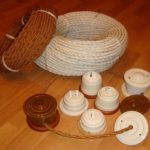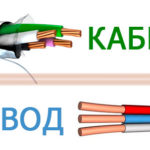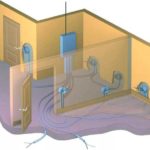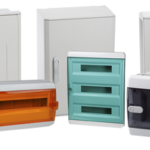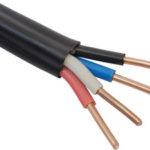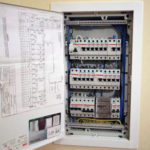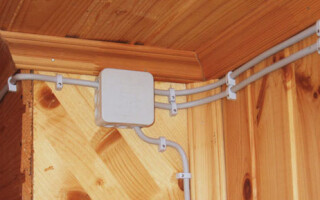A house made of wood is a beautiful, cozy structure, but it is easily inflammable, requiring increased attention to the process of electricity supply. Making electrical wiring with your own hands is not an easy task, but doable. Only to approach the issue responsibly, in accordance with the rules and regulations.
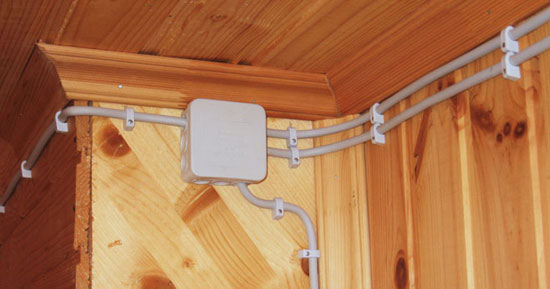
Contents
Requirements for the wiring of the wooden house
Electrical wiring in a wooden house must meet the main requirement - to be safe. More than half of the fires in this type of building are caused by a short circuit in the electrical system due to mechanical damage to the insulation or excessive stress on the cable.
You can eliminate the risk of fire if you follow the basic requirements:
- Proper selection of materials.
- Reliable insulation.
- Possibility of automatic interruption of the power supply.
- Regular network diagnostics.
Fulfilling these requirements will reduce the likelihood of a wooden structure fire and ensure the safety of property in both urban and suburban homes.
Regulations
The provisions governing the arrangement of power supply in wooden structures are contained in "Rules of Electrical Installation" (PUE) and in the Rulebook "Design and Installation of Electrical Installations of Residential and Public Buildings"..
They give criteria for selecting switchgear, conductors, automatics, lighting, indicate the terms used and their meaning.
Conducting electrical wiring is still regulated by the Building Code (SNiP).
SNiP 3.05-06-85 describe the ways of entering the power cable into the dwelling, and SNiP 31-02 - Requirements for the installation of power supply systems in residential buildings.
Preparation of the power supply project
The first stage of electrification of the object - the preparation of the project. In a private house, the drawing of a wiring diagram can be done by your own forces. To do this, you need a plan of the house with the placement of furniture, equipment, electrical appliances, the designation of outlets and switches. Notes the location of the switchboard and the passage of cable lines.
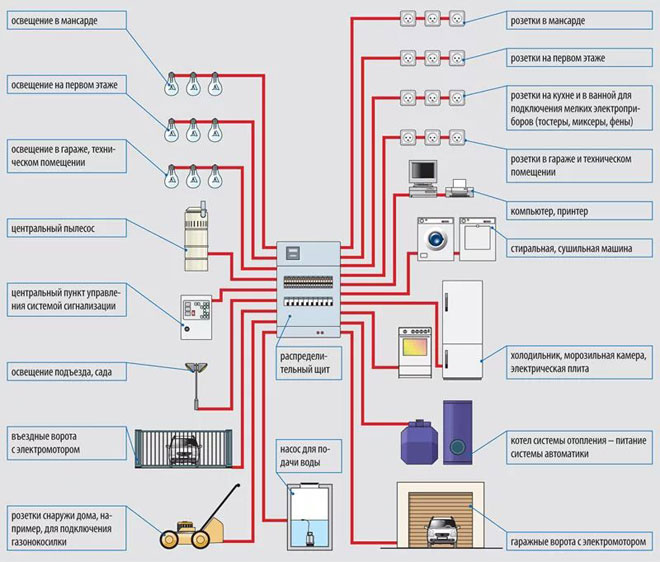
The location of junction boxes is indicated, the maximum power consumption by all appliances, the total number of circuit breakers and the rated load on the input circuit breaker is calculated.
Cable selection
After drawing up an electrical scheme, you need to decide what kind of wire to do wiring in a wooden house: aluminum or copper. The first - cheaper, the second - more reliable. When settling on aluminum, you must remember that its cross-section must be larger than that of copper, and it is brittle at bends. A more suitable material is copper, the wires of which can withstand temperatures from -50 to +50 ° C.
Determining, Which cable is better for wiring in the house, you can proceed to the selection of its brand. For wooden structures is more suitable copper non-flammable wire VVG with solid conductors and reduced smoke emission. It has high anti-corrosive properties and will not deform under temperature changes.
When planning how to wire the house, it is necessary to remember the requirements of PUE on the coloring of the insulation: the cable cores must be of different colors. This will simplify the process of installation, maintenance and repair.
Selection of devices and automatics for the switchboard
The purpose of the selection of automatic protection devices - the safety of the network and equipment in emergency situations. Each device has its own purpose. All devices are located in the switchboard.
Circuit breakers protect against overvoltage and short-circuits.
Circuit breakers protect against overvoltages and short circuits. (RCDS) - protect against fire and electric shock.
Voltage relays - against load surges that affect the operation of appliances.
RCCBs differential circuit breakers combine the functions of the circuit breaker and RCD and save space when installed in the switchboard.
The integrated use of these devices ensures reliable operation of devices and safety of people in the room.
Installing electrical wiring - step-by-step instructions
Installation of electrical wiring in a private home requires prior preparation and compliance with step-by-step instructions, consisting of the following steps:
- development of the project and determination of the total capacity of the equipment;
- Selection of cables, automation devices and electrical appliances;
- Power supply, connection of circuit breakers, power meters;
- electric board installation;
- internal wiring;
- installation of sockets, switches, lights;
- system test.
Such a sequence will show how to correctly distribute electrical wiring in the house, and ensure the reliability of its work. It is important to remember that each step should be carried out in accordance with safety rules: to de-energize the room in which work is carried out, do not use bare wires, all the connections and branches to place in boxes, lay the cable either vertically or horizontally, without allowing its intersection.
Following the step-by-step instructions will allow you to perform a quality installation.
Distribution switchboard installation
The distribution board is designed to receive and distribute electricity in the room. With its installation begins all electrical work. It does not matter whether the wiring is done in a summer house, a city cottage or a log cabin in the countryside.
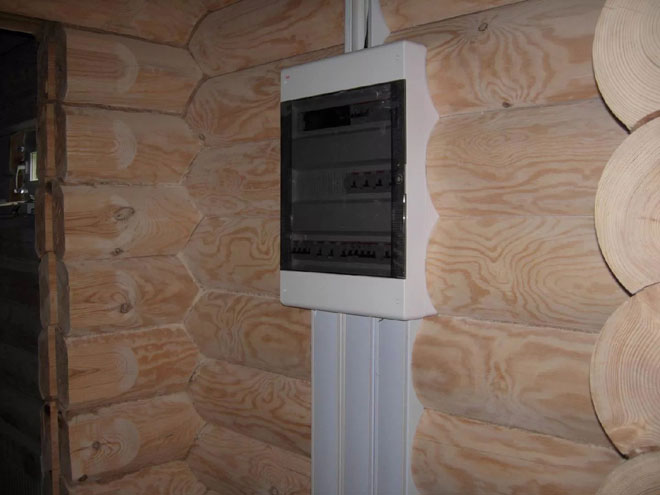
The switchboard must be made of fireproof material, placed in a dry place and locked. Above it may not be located rooms with high humidity (showers, bathtubs, toilets), and within a half-meter radius - heating equipment, water and gas supply systems.
In the switchboard is installed electric meter, input circuit breaker, RCD, grounding busbar, voltage relay and automatic circuit breakers for different power groups.
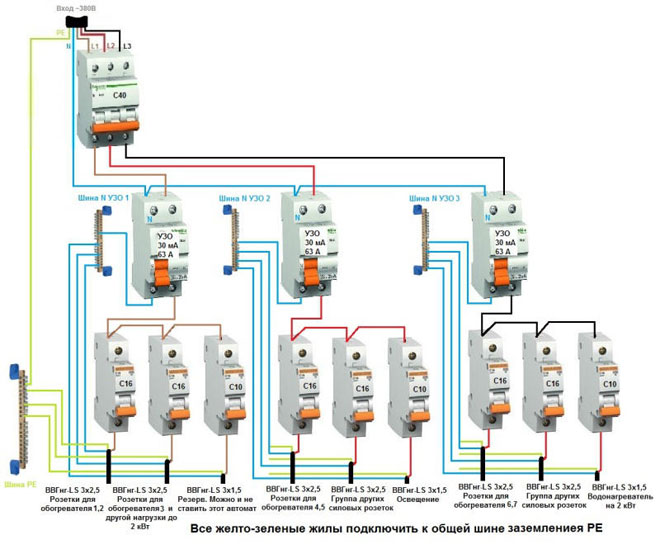
Earthing device
Any modern home is equipped with appliances in a metal case, and the possible contact of metal with electricity requires grounding - protecting people from electrocution through electrical appliances.
In a private home, grounding You can do it yourself.
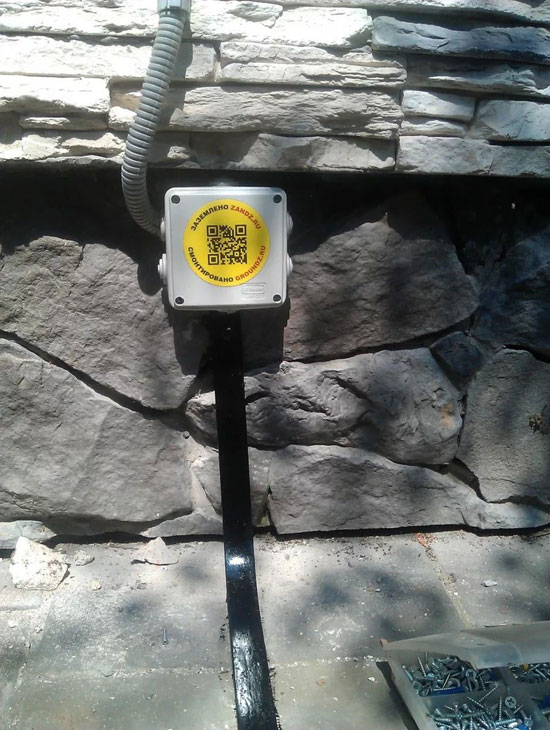
Dig a trench 30 cm deep in the form of an equilateral triangle with a side of 1 m. Pins 3 m long and 3 cm in diameter are hammered into the corners, which connect to each other with a corner weld.
In one of the corners of the hole is cut, with a bolt and nut attached grounding wire, which attaches to the bus in the switchboard. To this bus fasten grounding conductors of cables in a yellow-green insulation.
Entering a power cable into a building
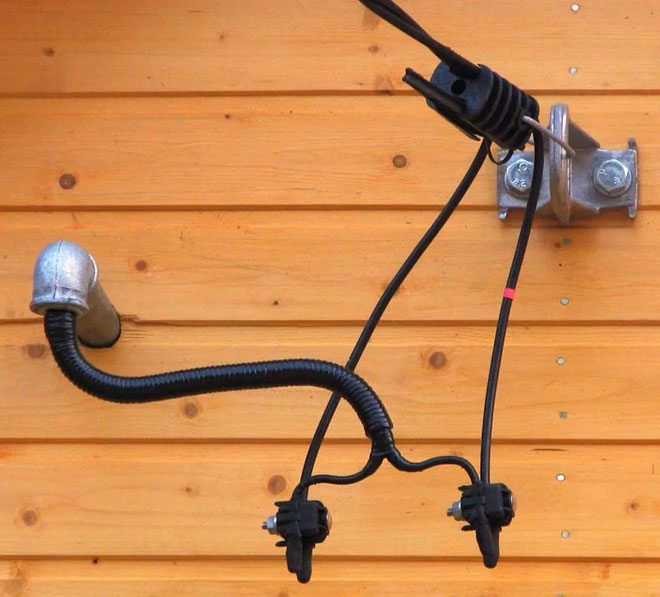
Electricity enters the building through the power cable that enters the switchboard. It can be supplied in two ways: overhead and underground.
In the first case, the cable is led through the air from the electric pole to the house, where it is attached to the porcelain fittings. This method is simple and cheap, but has a number of drawbacks: less durable, there is a high probability of damage to the wire by wind, snow, branches.
Underground method is more reliable, but more time-consuming and expensive. Digging a trench in which to lay an armored cable or metal pipes. A 20 cm layer of sand is poured on top of the trench, and a signal tape is laid and the trench is buried.
Power cable - is the main element of wiring because it carries the load of all electrical appliances in the house.
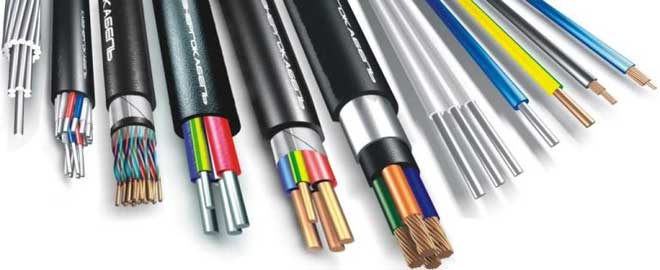
Installation of cables and their connection
Installation of electric wiring in a private house is carried out along the routes shown in the scheme of the project. According to it are mounted junction boxes, fixed mounting points sockets, switches, lighting fixtures. In buildings made of wood used only wires with special markings, insulation which does not ignite even at high temperatures.
Do not "twist", "temporary". It is better to minimize the number of turns and bends. Where possible, run a whole wire from the circuit breaker to the end point.
Performing installation of electrical wiring in a wooden house with your own hands, you must remember that the boxes can not be closed with decorative panels or floors that make it difficult to access for service.
Installing switches and outlets
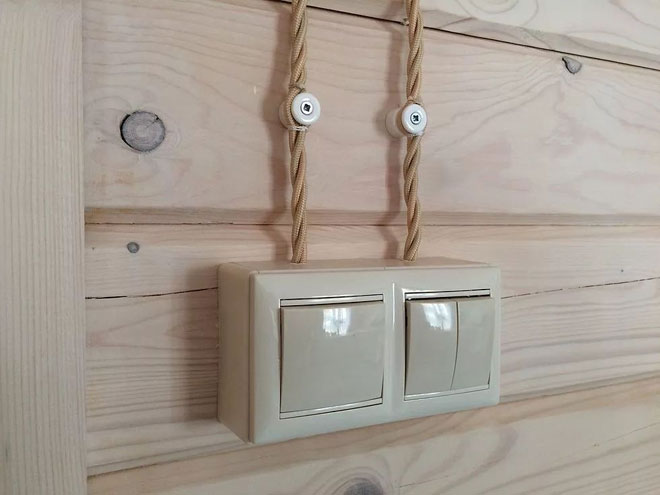
Overhead sockets and switches are selected on the basis of the calculated value of the current and the possibility of connection under one frame. Before installing, turn off the power and make sure there is no voltage in the cable.
The safest way to mount switches and outlets in a wooden structure is to mount them on metal substrates. This will protect against possible sparks from shorting or arcing when pulling out the plug. For a wooden house, it is preferable to use carbonite, rather than plastic, devices that have greater heat resistance and can withstand intense heat.
Methods of open wiring
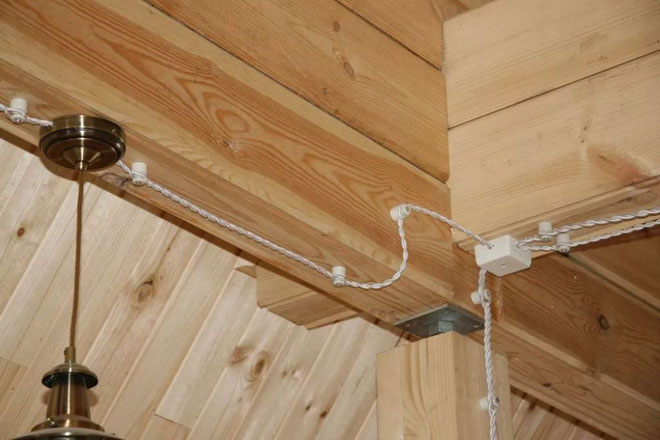
Open wiring in a wooden house is laid on the inside of the room. The main requirement is that the wire does not directly touch the walls, ceiling or floor and is protected: it is in the middle of a channel, pipe or has several layers of insulation. Pipes and ducts must be made of materials that do not support combustion.
Installation of wiring in a wooden house can be done in several ways:
- In corrugated pipe made of PVC;
- In metal hose;
- In pipes or ducts made of PVC;
- On the brackets;
- On ceramic insulators.
The most common options are the use of corrugated pipes and cable ducts.
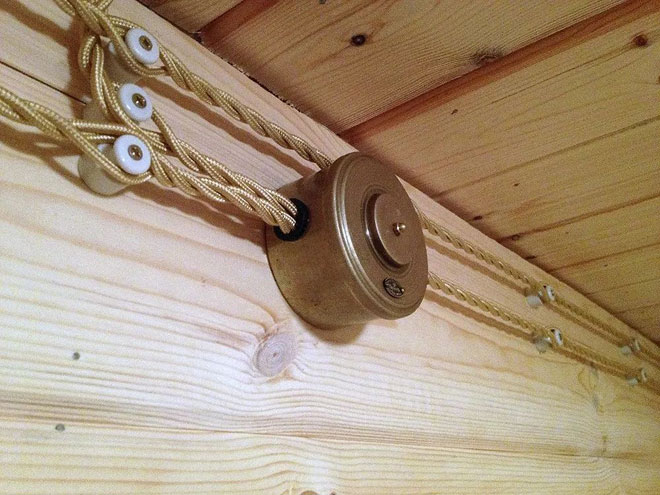
The use of ceramic insulators or "retro style"When there is an air gap between the stranded wire and the wall. This option also beautifies the house.
Open wiring in a wooden house can combine several options. On walls and ceilings that have a flat surface, you can apply plastic boxes, and in other areas - corrugated pipes.
Concealed wiring in a wooden house
Internal wiring in a wooden house has its own advantages and disadvantages. The advantage is the absence of corrugated pipes and cable channels, spoiling the appearance of the room. There is no risk of mechanical damage to the cable. On the other hand, the complexity of installation, increased requirements for fire safety, additional financial costs.
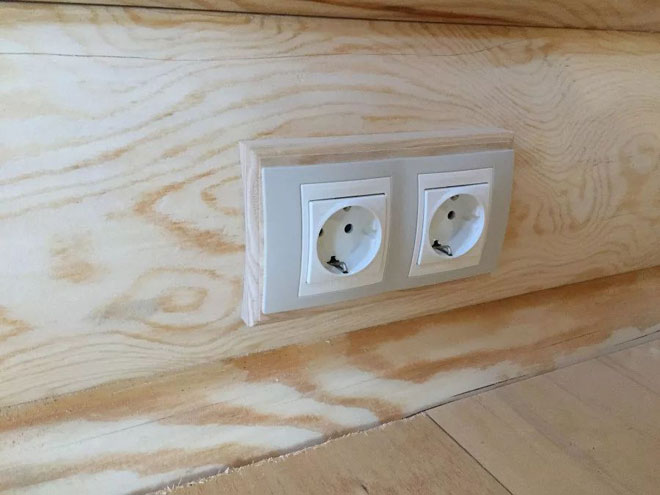
In contrast to the exterior, to conduct internal wiring in a wooden house is more difficult. You need to know more requirements and nuances related to this type of arrangement of electricity.
Concealed wiring should not have many turns, as the cable must be laid in steel or copper pipes. The use of metal hoses and PVC gauze is allowed only if they are protected with plaster or asbestos gasket.
If the installation of external wiring does not require a special tool, it is necessary for hidden wiring. You need to drill in the horizontal and vertical directions, cutting slots for the insulating boxes. You will have to pull not only wires and cables, but also a large number of steel or copper pipes. The latter are better suited, as they bend well, taking the desired shape.
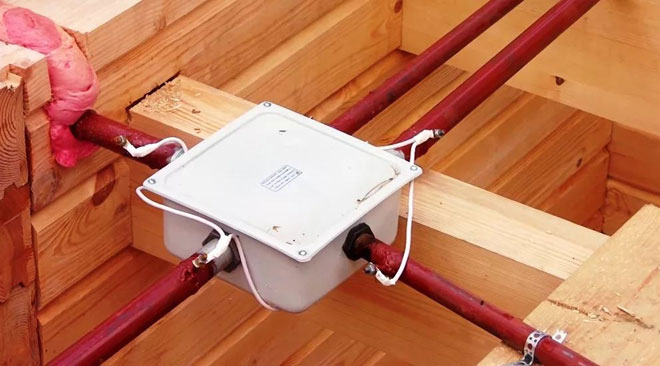
To conduct wiring in the house with their own hands can be open and closed. This is done in the places where the wire is led to switches or outlets.
Errors during installation
Typical mistakes when laying electrical wiring in the premises:
- Bending or loosening the supply cable;
- Fixing the wire to a wooden structure, which is prohibited by regulations;
- Installation of concealed wiring with corrugated pipes, metal hoses and plastic boxes;
- installation of the switchboard too close to the place where the power cable enters;
- The number of circuit breakers is calculated incorrectly: either more or less than necessary.
Testing the wiring
After installation the wiring should be tested: make a visual inspection, measure the insulation resistance and grounding wire, check the operation of circuit breakers, RCDs or flame arresters. Reliability of the power grid should be the maximum, as electrical wiring requires increased attention and regular monitoring.
Related articles:
